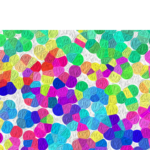
Physicochemical characteristics and toxicity of nanomaterials

“Physicochemical characteristics” and toxicity of nanomaterials
By the AVICENN team – Last updated June 2022
At the nano scale, we can no longer consider that “it is the dose that makes the poison”. This sentence from the physician and alchemist Paracelsus, the “father” of toxicology, is very often invoked to evaluate the risks related to synthetic chemicals. Scientifically, it is now being questioned, especially in the specific case of nanomaterial toxicity, which is strongly influenced by the physicochemical characteristics of the nanomaterials considered.
Each of the parameters mentioned below affects the toxicity of nanomaterials and each of these is itself subject to variation during the life cycle of nanomaterials. Hence the complexity, for researchers, to evaluate the toxicity of nanomaterials.
– Their chemical composition:
- This is the identity of the substance, for example “silver” or “titanium dioxide”.
- One can extrapolate the knowledge one has about the substance to the macro state, whose known properties (and sometimes toxicity) can be increased tenfold due to surface reactivity.
- New properties (or new toxicity) may also appear specifically at the nanoscale; they are much more difficult to predict, and often not enough is known about them.
- However, nanomaterials of the same family cannot be considered as a “monosubstance”: within the same family, different substances can present different toxicity and genotoxicity1Results of the European Nanogenotox program on the genotoxicity of nanomaterials, presented in French at ANSES, during the ‘Restitution du programme national de recherche environnement santé travail’: Substances chimiques et nanoparticules: modèles pour l’étude des expositions et des effets sanitaires: Dossier du participant et Diaporama, November 2013. And “Toxicological assessment of nanomaterials needs to evolve, says European research project,” APM International, November 14, 2013. On the genotoxicity of nanomaterials, see also: Genotoxicity of Manufactured Nanomaterials: Report of the OECD expert meeting, OECD, December 2014.
– Their dimension (size and size distribution):
Their nanometric size allows nanomaterials to penetrate the cell and cause adverse effects2See for example Size determines how nanoparticles affect biological membranes, Dunning, H., Imperial College London, September 17, 2020 (press release) and Size dependency of gold nanoparticles interacting with model membranes, Contini, C et al, Nature Communications Chemistry, 130, 2020. Their size is not the only factor and the items below are also decisive.
– Their shape (or morphology):
There is a great diversity of nanoparticle shapes: nanotubes, nanowires, nanosheets, nanocubes, etc. It seems that the tubular, fibrous or multifaceted structures present a greater toxicity than the smooth structures (such as spheres), in connection with the surface reactivity3See for example: The influence of surface coatings of silver nanoparticles on the bioavailability and toxicity to elliptio complanata mussels Auclair J et al, Journal of Nanomaterials, 2019 : Silver nanoparticles harm mussels: high silver levels in freshwater mussels are linked to reduced survival time in air, weight loss during air exposure, and DNA damage.. The toxic action can also be more important on one of the facets, for example for nanomaterials of complex shape and nature (but again, this will depend on the type of nanomaterial).
– Their specific surface :
This is the surface area of a particle or a material in relation to its volume. It has an important role in explaining certain changes in the behavior of the same material (e.g. powdered sugar will melt more quickly in hot tea than a large lump of sugar).
– Their surface reactivity / surface chemistry (and if necessary, their outer cover: coating or encapsulation)
– Their state of charge
– Their degrees of agglomeration / aggregation:
- Note: Research conducted in Belgium and published in 2020 shows that aggregates larger than 100 nm should not necessarily be considered less toxic than their nanometric counterparts, whether they are silica nanoparticles4Cf. Assessing the Toxicological Relevance of Nanomaterial Agglomerates and Aggregates Using Realistic Exposure In Vitro, Murugadoss S et al, Nanomaterials, 11, 1793, 2021 and Is aggregated synthetic amorphous silica toxicologically relevant, Murugadoss S et al, Particle and Fibre Toxicology, 17(1), 2020 or titanium dioxide nanoparticles5Cf. Agglomeration of titanium dioxide nanoparticles increases toxicological responses in vitro and in vivo, Murugadoss S et al, Particle and Fibre Toxicology, 17(10), 2020.
– Their solubility (in water, biological fluids, …)
– Their crystallinity
– Their powderiness
– In French :
-
Particulate surface area retained following acute, subacute and subchronic inhalation of nanomaterials governs the pulmonary inflammatory response in rats, INRS, Particle and Fibre Toxicology, 18(29), August 2021
-
Cahier de la recherche n°17 : “Microplastics and nanomaterials”- Understanding the state of research, ANSES, May 2021
- The importance of protein size in protein-nanoparticle interactions, INC, CNRS, January 2021
- Impact of physicochemical characteristics on the respiratory inflammatory and pro-allergic effect of manufactured nanoparticles, Françoise Pons, University of Strasbourg, presentation at the Anses & ADEME Scientific Meetings on Air Quality, October 17, 2019
- Dossier “Characterizing nanomaterials”, LNE, September 2017
- Properly characterizing the infinitesimally small to contribute to the responsible development of nanotechnologies, Nicolas Feltin, Les Echos, September 19, 2017
- Opportunities and Risks of Nanomaterials – Results, Conclusions and Perspectives – Final brochure, National Research Programme NRP 64, Swiss National Science Foundation, March 2017
- Toxicological assessment of metal oxide nanomaterials: what is the current place for “structure-activity” modeling, Environment, Risks & Health, 15(6), November-December 2016
- Francelyne Marano, Faut-il avoir peur des nanos ?, Buchet Chastel, April 2016
- Is there a link between physicochemical characteristics of nanomaterials and their ecotoxicity, Camille Larue, ANSES Scientific Watch Bulletin, July 2014
- Evaluation of the risks associated with nanomaterials – Issues and knowledge update, ANSES, April 2014 (online May 15, 2014)
- Nanomaterials: a review of definitions, applications, health effects and means to implement for a safe development, Eric Gaffet, Comptes Rendus Physique, Volume 12, issue 7, pages 648-658, September 2011
- Influence of the physicochemical characteristics of nanomaterials on their toxicity, Marie CARRIÈRE and Mary-Line JUGAN, Bulletin de Veille Scientifique, 10 ANSES, 2010
- How to characterize nanomaterials, SCENIHR, 2009
In English:
- Influence of Critical Parameters on Cytotoxicity Induced by Mesoporous Silica Nanoparticles, Ahmadi A et al, Nanomaterials,12(12), 2022
-
Retained particle surface area dose drives inflammation in rat lungs following acute, subacute, and subchronic inhalation of nanomaterials, Cosnier, F et al, Particle and Fibre Toxicology, 18(29), August 2021
-
Nanomaterials shape and form influences their ability to cross the blood brain barrier, University of Birmingham, July 2021 (press release); Biotransformation modulates the penetration of metallic nanomaterials across an artificial blood-brain barrier model, Guo Z et al, PNAS, 118 (28), July 2021
- Impact of the Physicochemical Features of TiO2 Nanoparticles on Their In Vitro Toxicity, Kose O et al, Chemical Research in Toxicology, 33 (9), 2324-2337, 2020
- Identification of the physical-chemical properties that modulate the nanoparticles aggregation in blood, Soddu L et al, Beilstein J. Nanotechnol, 11, 550-567, 2020
- ENANOMAPPER An integrated approach to nanotechnology safety, Cordis, January 2018
- Reproducibility, sharing and progress in nanomaterial databases, Nature Nanotechnology, 12(12): 1111-1114, December 2017
- Physical-chemical parameters: Measurements and methods relevant for the regulation of nanomaterials, OECD, January 2016
- Dissolution and biodurability: Important parameters needed for risk assessment of nanomaterials, Utembe W et al, Particle and Fibre Toxicology, 12:11, 2015
- Toxicity Risks of Engineered Nanomaterials, CIEL, ECOS and Öko Institut, January 2015
- Genotoxicity of Manufactured Nanomaterials: report of the OECD expert meeting, OECD, December 2014
- The dialogue continues, Nature Nanotechnology, 8, 69, February 2013 : The nanotoxicology community has numerous ideas and initiatives for improving the quality of published papers.
- Join the dialogue, Nature Nanotechnology, 7, 545, August 2012: The nanotoxicology community should implement guidelines on the types of information that are required in their research articles to improve the quality and relevance of the published papers.
Any questions or comments? This information sheet compiled by AVICENN is intended to be completed and updated. Please feel free to contribute.
Other news on the topic
Upcoming Nano Agenda

- Webconference for analysis laboratories, plant fertilizer manufacturers and distributors, public authorities…
- Moderated by David Krupka, nanotechnologies development manager at AFNOR Normalisation and Emilie Langlois-Bertrand, nantechnologies standardization project manager.
- In partnership with Armand Masion, CNRS Research Director, and Sandrine Mocoeur, Health, Safety, Environment and Quality Manager at SYNGENTA.
- This exchange will also be an opportunity to explore the creation of a national platform to identify standardization needs.
- Website: www.afnor.org/evenement/nanotechnologies-agriculture-cadre-pratique-responsable/
- 8th Congress of Occupational Medicine and Health (CNMST 2026)
- Theme 5: Emerging pathologies and risks, Mr Henri Bastos (ANSES), Pr Lynda Bensefa-Colas (AP-HP), Dr Catherine Nisse (CHU Lille)
- Website: www.medecine-sante-travail.com
- 20th meeting of the “nano and health” dialogue committee
- Organizer: ANSES
Created in November 2013
Notes and references
- 1Results of the European Nanogenotox program on the genotoxicity of nanomaterials, presented in French at ANSES, during the ‘Restitution du programme national de recherche environnement santé travail’: Substances chimiques et nanoparticules: modèles pour l’étude des expositions et des effets sanitaires: Dossier du participant et Diaporama, November 2013. And “Toxicological assessment of nanomaterials needs to evolve, says European research project,” APM International, November 14, 2013. On the genotoxicity of nanomaterials, see also: Genotoxicity of Manufactured Nanomaterials: Report of the OECD expert meeting, OECD, December 2014
- 2See for example Size determines how nanoparticles affect biological membranes, Dunning, H., Imperial College London, September 17, 2020 (press release) and Size dependency of gold nanoparticles interacting with model membranes, Contini, C et al, Nature Communications Chemistry, 130, 2020
- 3See for example: The influence of surface coatings of silver nanoparticles on the bioavailability and toxicity to elliptio complanata mussels Auclair J et al, Journal of Nanomaterials, 2019 : Silver nanoparticles harm mussels: high silver levels in freshwater mussels are linked to reduced survival time in air, weight loss during air exposure, and DNA damage.
- 4Cf. Assessing the Toxicological Relevance of Nanomaterial Agglomerates and Aggregates Using Realistic Exposure In Vitro, Murugadoss S et al, Nanomaterials, 11, 1793, 2021 and Is aggregated synthetic amorphous silica toxicologically relevant, Murugadoss S et al, Particle and Fibre Toxicology, 17(1), 2020
- 5Cf. Agglomeration of titanium dioxide nanoparticles increases toxicological responses in vitro and in vivo, Murugadoss S et al, Particle and Fibre Toxicology, 17(10), 2020



